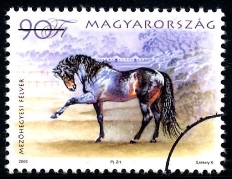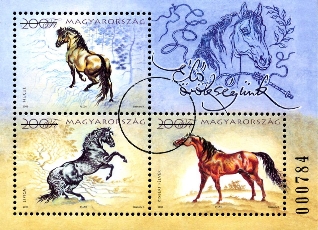OUR LIVING HERITAGE II – HORSES
Date of issue: 9 May 2006
The Hucul, Lipizzaner and Kisbér halfbred are the breeds shown on the numbered block. The drawing in the frame of the block has an embossed horse’s head and an inscription “Our Living Heritage”. The stamps forming the set show horses in their natural environment, just as those of the block do. In order of ascending face value the breeds featured are Shagya Arab, Mezőhegyes halfbred, Gidran and Noniusz. Different aspects of horses feature in the graphics of the first day cover and postmark

Hucul – Two wild horses, the Taki and Tarpan, played a part in the creation of the breed. As early as 1606 it was mentioned as a breed albeit not in the modern day sense. It is an outstanding workhorse, best suited to narrow mountain paths. Its docile nature also makes it a popular horse for children.
Lipizzaner – The stud was established by Prince Charles Habsburg in 1850. Today it is part of European cultural heritage. In the 1950s the breed’s stock came to Szilvásvárad, where today they preserve their excellent reputation as a dressage horse. The Lipizzaner has always meant elegance and for this reason has never spread in large numbers.
Kisbér halfbred – After the 1848-49 War of Independence Count Kázmér Batthyány’s estate in Kisbér was confiscated in order to create a noble military stud. This was accomplished and legendary thoroughbreds covered here such as the father of the unbeat-able racehorse Kincsem.
Shagya Arab – Eastern horses were famed in ancient times and again won a deserved reputation at the time of the prophet Mo-hamed. Arabs have been consistently used in Hungarian horse breeding since the 16th-17th-century Turkish occupation of Hungary. The celebrated Arab stud farm Bábolna was established by Joseph II in 1789.
Mezőhegyes halfbred – In 1841 the English thoroughbred stallion Furioso arrived in Mezőhegyes. He retired from the race-course unbeaten. His genetic value was demonstrated by the fact that his brother was likewise unbeaten. His descendants have become hunting horses and are also used in harness.
Gidran – The stallion used to found the breed was bought in Egypt in 1816, and first went to Lipizza, then Bábolna. In the early 1900s it was tried with success in foxhunting. Maintaining the purity of the breed is also important from the aspect of world heritage.
Noniusz – The development of the breed is linked to the Mezőhegyes stud farm in 1785. The breed’s heyday was in the years after the 1867 Compromise. After the Second World War its use as a military horse ceased, and it became a draught horse on the Great Plain. Today the Noniusz enjoys great success in carriage driving.

Source: www.magyarallat.hu
Order code:
2006110030011 (block)
2006110060012 (block FDC)
2006100050411 (set)
2006100060012 (set FDC)
Printed by Pénzjegynyomda Zrt.
Printing method: offset and embossed
Date of issue: 9 May 2006
Designed by Kálmán Székely
Total face value of block: HUF 600
Total face value of set: HUF 465
Number of copies: 150,000 numbered blocks
Number of copies: 250,000 sets (in sheets of 50 stamps)
Trimmed size of block: 95 x 70 mm, perforated size of stamps: 40 x 30 mm.
Perforated size of stamps: 40 x 30 mm

